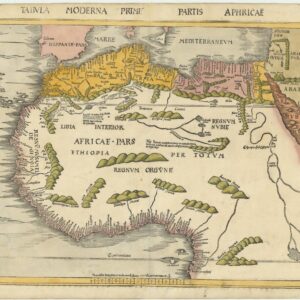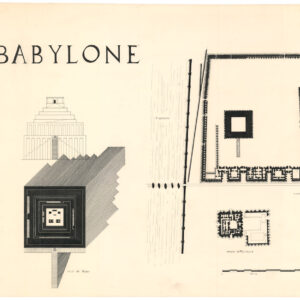Likely the first printed map of Africa by a female cartographer.
Africa.
Out of stock
Description
Margaret Whiting Spilhaus is one of only a handful of female mapmakers born before the 20th century. Working from colonial South Africa, her claim to cartographic fame was a series of five pictorial maps, produced mainly for educational purposes, and respectively depicting Africa (ca. 1925), Australia (ca. 1927), North America (1931), South America (1938), and Pan-Africa (1943).
This pictorial map of Africa was Spilhaus’ first cartographic production and, thus, one of the milestones in the early history of female cartography. This large wall map of Africa elevated Spilhaus from an illustrator to an actual mapmaker. The chart was designed to be a visual tool for educating South African school children of European descent. The map abounds in graphic detail but also delineates the national boundaries at the time.
The illustrations depict a cornucopia of all things African, from iconic flora and fauna to indigenous tribes and peoples. In some cases, important cities like Timbuktu and Khartoum are indicated using architecture. The surrounding maritime sphere is also full of details such as trans-oceanic steamers; whales, sharks, and porpoises; and local fishing boats and trading vessels along the shore.
Around the edges of the map, we find decorative mermaids shaping the circular space in which the map is presented. The geography is defined by a series of 18 vignettes along the top and bottom, each depicting what Europeans perceived as decisive events in African history. Except for the earliest event in the upper left corner, all these are related to the European discovery and subjugation of Africa. Most of them refer to well-known English explorers such as Mungo Park, Stanley, or David Livingstone, but the early influence of the Portuguese and Dutch is also clearly noted.
The only scenes that can be classified as actual events of endogenous African history are Pharaoh Necho II’s ordering of a Phoenician expedition to round the cape (according to Herodotus) and the female pharaoh Hatshepsut’s mounting of an expedition to Punt in 1600 BC (upper right corner). This reference may be Spilhaus’ nod to another trailblazing woman like herself. Along both flanks of the map, we find an African tribesman kneeling, with an arrow knocked and ready to fly. The line created by the arrows represents the equator.
The blatant colonial idealism that Spilhaus affirms in her composition is seen not only in the vignettes of “African history” but also in the flags of its colonizers (incl. USA) waving at the top of the composition. In the upper left corner, an image of the European explorer traversing the wilds of Africa in a pith helmet conveys the standard Western narrative at the time, namely that of Europe’s civilizing effect on African peoples. As if to hammer the underlying racism home, a vignette in the lower right corner shows an explicitly white child standing by an antelope in front of a wreath that reads: ‘Behold Child, Your Heritage.’ Across from this image, in the lower left corner, we find the title of the map – Africa – as well as a key to the natural resource symbols used.
Spilhaus wrote an explanation of the map:
Climate is a dull fact until we understand its influence upon the lives of men; upon their industry; upon vegetation, which is their food and their environment. It is also a psychological truth that whenever we sound the human note we arouse the interest of the child, and interest means the retention of the lesson in memory, and therefore work of real educative value.
This new map is designed to complement the ordinary class map. It is not intended to replace the geographer’s work. An attempt to combine in so small a compass a mass of geographical detail with the details of human interest would result in confusion. The attempt is to give the child an insight of the life of the country, and to inspire him with its possibilities of development and adventure.
Our children in Africa have a special heritage, and a special responsibility. Africa is a mine of treasure. The romance of its magnificent possibilities from north to south progressively unfolds to the student, and he discovers with ever-increasing passion that the Golden Age is not yet passed. There comes a day when he will stand before a new revelation, “Silent, upon a peak in Darien.
There can be little doubt as to Spilhaus’ pedagogical intentions, but at the same time, her ideological standing is also abundantly clear. She grew up in an age and place where colonial rule and European supremacy was a given. Her goal with this map was to educate and instill a sense of Africa’s diversity and grandeur in those children she imagined one day would govern her.
Census
While we expect a decent number of Margaret Whiting Spilhaus’ maps to be held in various collections in South Africa, the OCLC lists only two institutional examples of this particular map: one at the National Library of Wales, the other at Buffalo & Eerie County Library (no. 1118033257). We have also identified an example in the collections of the British National Trust (NT 23215).
This example was printed by Cape Times Ltd. and sold by George Philip & Son.
Cartographer(s):
George Philip (1800–1882) was a cartographer, map publisher and founder of the publishing house George Philip & Son Ltd.
Margaret Whiting SpilhausMargaret Whiting Spilhaus (September 27, 1889 – July 7, 1981) was a South African author, illustrator, geographer, and historian of British descent. Born in London, she moved to South Africa with her family in 1904. She married a German merchant, Ludolph Spilhaus (1876 – 1972), in 1909 and later started her publishing career by writing and illustrating books for toddlers (e.g. South African Nursery Rhymes in 1924 and The Limber Elf in 1926).
Over time, Spilhaus gradually began focusing on older children. As part of that, she created a series of pictorial maps for educational purposes. These include Australia (c. 1927), Africa, North America (c. 1930), South America (c. 1933), and Pan Africa (c. 1943). Spilhaus died in South Africa in July of 1981; her personal archive is housed at the University of Cape Town today.
Condition Description
Good. Pasted on thick paper board. Some wear and discoloration around edge from framing.
References
![[3-Sheet Biodiversity Map of Madagascar] Carte Internationale du Tapis Végétal et des Conditions Écologiques.](https://neatlinemaps.com/wp-content/uploads/2024/05/NL-01035-middle_thumbnail-300x300.jpg)

![[South Africa] Photograph panorama of Cape Town, c. 1870](https://neatlinemaps.com/wp-content/uploads/2022/09/Screen-Shot-2022-12-18-at-11.22.15-AM-300x300.png)
